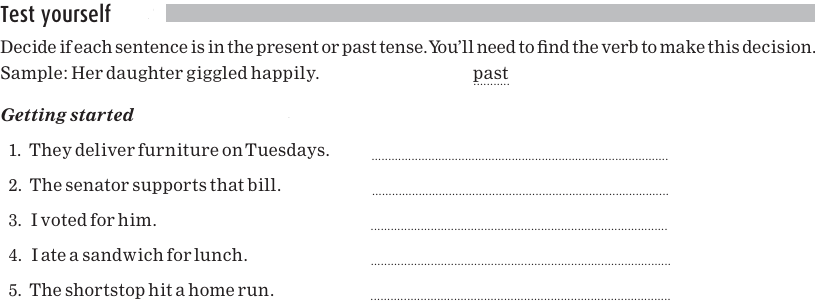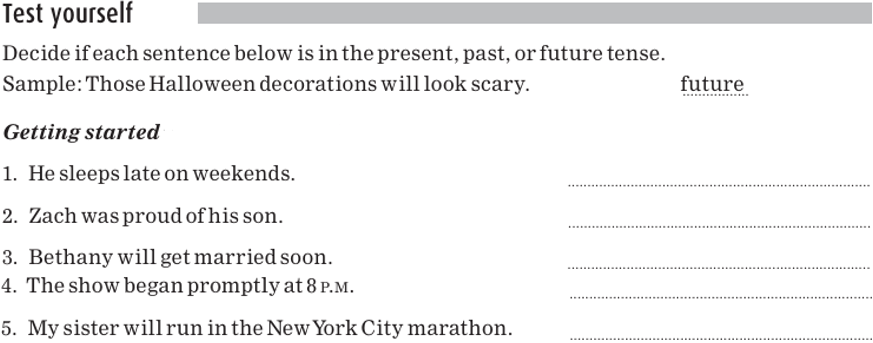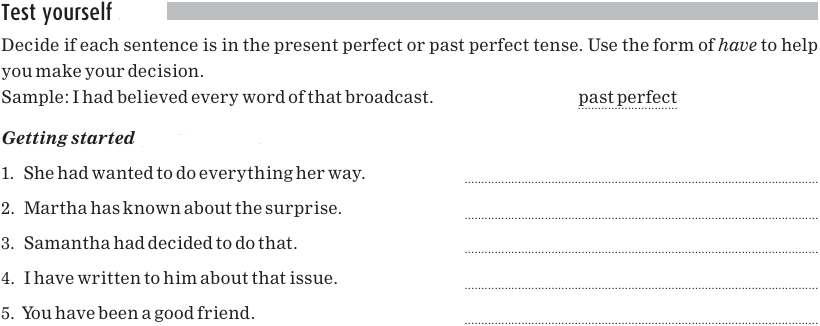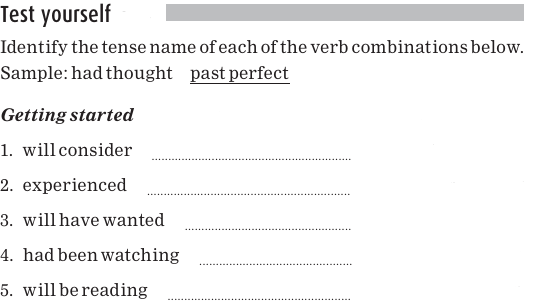Tense
The verb of a sentence gives information about tense. Speakers of English generally are aware that, for example, the verb studies is a present tense form while the verb studied is a past tense form.

Answers

It’s important to understand that grammatical tense and real-world time are not necessarily the same. Take a look at the following sentences:
1. She studied yesterday.
2. She was studying yesterday.
In sentences 1 and 2, the tense of the underlined verbs, as seen in their forms, is past; the time that is being talked about is also past. So, in these cases, tense and time are the same.
Now consider the following sentences:
3. I am going to France next summer.
4. She has bought the books for the course.
In sentences 3 and 4, the grammatical tense of the underlined verbs is present. (If these verbs were past tense forms, they would be was and had, respectively). However, the real life or actual time that sentence 3 is talking about is in the future; the actual time that sentence 4 is talking about is in the past. So, in sentences 3 and 4 we can see that grammatical tense and real-life time are not always the same.
We’ll be focusing on the tense (grammatical form) and not the real-life time of English verbs.
Quick tip
Time refers to a point in real life at which something occurs. Tense refers to the grammatical form of a verb.
In a simple sentence, tense information is carried by only one verb. If a sentence has helping verbs as well as a main verb, which verb shows tense? In each of the sentences below, the verb that carries the tense information is underlined.
5. John studies.
6. John studied.
7. John has studied.
8. John had studied.
9. John is studying.
10. John was studying.
11. John has been studying.
12. John had been studying.
You can see that in each sentence it is the very first verb that carries the tense information, regardless of whether it’s a helping verb or the main verb.
You will notice that we have not included in our list of sentences in 5 through 12 examples of sentences whose first verb is a modal. (Recall from Progressive be that modals always come first in sentences with more than one verb.) That is because in general, modals do not carry clear tense information. Look at the following examples:
13. I might do it right now/today.
14. I might do it tomorrow.
15. I might have done it yesterday.
As you can see, the form of the modal is the same (might), regardless of whether it refers to time in the present (sentence 13), time in the future (sentence 14), or time in the past (sentence 15). We will consider modals to be tenseless.
Quick tip
Tense information is always indicated by the first verb in the sentence, excluding modals.
Traditionally, sentences have been grouped into different types, according to the tense of the verb. Let’s compare the following two sentences:
16. John studies every day.
17. John studied every day
You can see that the only difference between sentence 16 and sentence 17 is that in 16, study is in its present tense form and in17 study is in its past tense form. On this basis, sentence 16 has present tense (or simple present tense), while sentence 17 has past tense (or simple past tense).
Here are some more examples, with the verbs underlined:
18. Ira sighed in relief. (past)
19. Alice sees her often. (present)
20. He laughed hysterically. (past)
21. I often forget the answer. (present)
Quick tip
Sentences with no helping verb are in either the present or past tense, depending on the form of the verb.
Almost all verbs, like the verbs in sentences 18 and 20, form their past tense by adding the suffix -ed. These verbs are called regular verbs. Some verbs, however, do not follow this pattern. These verbs are called irregular verbs. Some examples of irregular verbs are: see (past tense saw), write (past tense wrote), and hit (past tense hit).

Answers

The next two sentences have future tense (or simple future tense): they have the modal helping verb will, followed by the base of the main verb.
22. John will study tomorrow.
23. Jessica will visit her soon.
Quick tip
Sentences with will followed by the main verb are in the future tense.
The future tense can also be expressed with the modal helping verb shall: e.g. John shall study tomorrow. Shall has restricted usage in American English: generally, it’s used only in formal speech styles. Consequently, we’ll ignore shall in our discussion here.

Answers

As we saw above (in sentences 4, 11, and 12), sentences with the have helping verb also change in form to indicate tense:
24. I have bought the books.
25. I had bought the books.
The difference between the two sentences is that sentence 24 is in the present tense, while sentence 25 is in the past tense. Notice that it is only the form of have that changes to indicate the tense information. The verb after have is always in its past participle form, which does not change to indicate tense. Although sentences with the have helping verb are in the perfect aspect, when we talk about a sentence with both tense and aspect, we just use the term ‘‘tense.’’ So therefore sentence 24 is in the present perfect tense while sentence 25 is in the past perfect tense.
Quick tip
If a sentence has a form of have as a helping verb, it will have the word perfect as part of the name of its tense.
Quick tip
The present tense forms of have are have and has. The past tense form of have is had.

Answers

What do you think is the tense of the following sentences?
26. John will have studied by then.
27. It will have been an easy test.
Since these sentences have both will and a form of have as helping verbs, they are in the future perfect tense.
Quick tip
If a sentence has will as a helping verb, it will have the word future as part of the name of its tense.

Answers

Last, we come to sentences with a form of be as a helping verb. These also change in form to indicate tense:
28. I am buying the book.
29. I was buying the book.
The difference between the two sentences is that sentence 28 is in the present tense, while sentence 29 is in the past tense. Notice that the verb after be is in its present participle form (that is, its- ing form), which does not change to indicate tense. Remember that although sentences with the be helping verb are in the progressive aspect, when we talk about a sentence with both tense and aspect, we just use the term ‘‘tense.’’ So therefore sentence 28 is in the present progressive tense while sentence 29 is in the past progressive tense.
As you might expect, the following sentences are in the future progressive tense:
30. I will be leaving at three o’clock.
31.Harry will be running the marathon.
You can see that they have both will and be as helping verbs.
Quick tip
If a sentence has a form of be as a helping verb, it will have the word progressive as part of the name of its tense.
Quick tip
The present tense forms of be are am, is, and are. The past tense forms of be are was and were.

Answers

Since sentences can have more than one helping verb, their tenses can have combinations of the words present, past, future, perfect, and progressive in their names. Here are examples of each of the possible tenses:
32. Mary speaks to everyone. (present)
33. Mary spoke to everyone. (past)
34. Mary will speak to everyone. (future)
35. Mary has spoken to everyone. (present perfect)
36. Mary had spoken to everyone. (past perfect)
37. Mary will have spoken to everyone. (future perfect)
38. Mary is speaking to everyone. (present progressive)
39. Mary was speaking to everyone. (past progressive)
40. Mary will be speaking to everyone. (future progressive)
41. Mary has been speaking to everyone. (present perfect progressive)
42. Mary had been speaking to everyone. (past perfect progressive)
43. Mary will have been speaking to everyone. (future perfect progressive)
To sum up:
(a)A sentence with will always has the word future in its tense name.
(b)A sentence with a have helping verb always has the word perfect in its tense name.
(c)A sentence with a be helping verb followed by a verb in its-ing formal ways has the word progressive in its tense name.
(d) For sentences without will, look at the form of the first helping verb, if there is one, or of the main verb, if there’s no helping verb, to decide if the tense is present or past.

Answers


Answers

 الاكثر قراءة في Grammar
الاكثر قراءة في Grammar
 اخر الاخبار
اخر الاخبار
اخبار العتبة العباسية المقدسة


